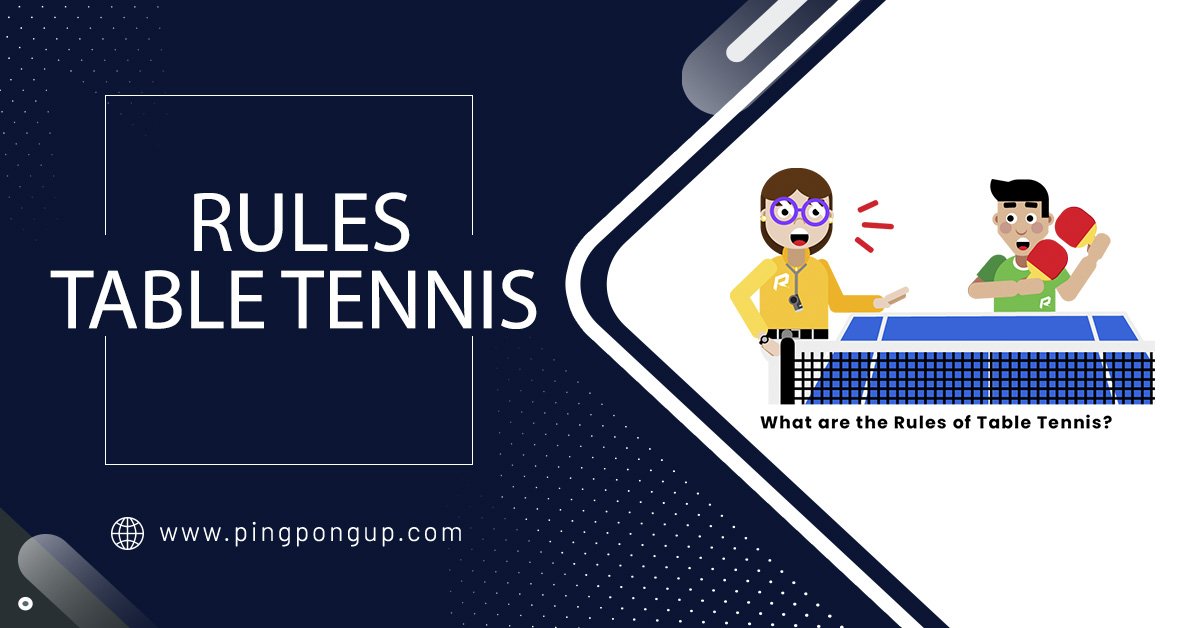Table tennis originated from a recreational game named ping-pong many years ago. When ping-pong was played at household parties or sports clubs, table tennis was not a well-known term. With the passage of time, some companies started manufacturing professional equipment for ping pong unofficial tournaments, and then this game started gaining popularity.
Now, ping-pong is officially known as Table Tennis and is played worldwide at the National and International levels.
There are various ways, techniques, and set Rules and regulations standardized by the International Table Tennis Federation. These rules are mandatory for everyone to study in detail whether they are interested in becoming a Table Tennis Player or already a professional.
According to my experience, there are more than 8 official rules of Table Tennis as per the ITTF protocol.

Let’s quickly go through all of these rules in a comprehensive and understandable description:
1- Total Points to decide the Winner/Loser:
According to International Table Tennis Federation, there is a total of 11 points that have to be scored by either of the parties in a single table tennis match. Going deep into the scoring criterion, further sub-rules have been announced by ITTF to evaluate which move shall be considered a fault and which stroke shall be considered a point. Also, check the Best Ping Pong Paddle Case.
- Scoring a point during serve:
For example, in the case of singles when a total number of players are two and one player on each side of the table is standing. Once the match starts after tossing, whichever player has decided to go for the serving should keep in mind all the mandatory serving rules. If the server accidentally hit the ball to the net and the ball reverts back to his side instead of going forward towards the opposite side he will be considered at fault and the opponent player would get a point.
- Not scoring a point during serve:
Similarly, if the ball touches the net but did not bonces back towards the server, this wouldn’t be a fault and no point will be given to any of the two players.
Winner Team/Player in a Table Tennis Match:
In a similar way, the player or the team (in the case of doubles) who successfully makes 11 points making sure that the other team is two points behind, then the first team shall be declared the winner.

2- The Rule of Alternate Serves & How to choose the Server?
At the beginning of the match, it is important to legally decide who is going to play first. The player who wins the toss by flipping coins method would decide if he is going to start the first move or not. The player who makes the first move is known as a ‘’Server’’ and the first shot is known as the ‘’Serve’’ or ‘’Service’’.
This is a standardized regulation by the International Table Tennis Federation that after scoring two points by either of the players/teams, the service will change. Also, check the How to Choose Ping Pong Paddle?
For example, if Team A won the toss and decides to serve if Team A or even Team B makes two points/scores, the next service would be shifted to Team B and vice versa.
This is the rule of alternate serving that after every two scores, the serving team will be changed alternatively.
3- Direction of ball tossing while serving:
This rule is given high importance because this move is the first move and decides the core competency of the player. A player can lose or gain confidence based on how successful and unsuccessful a serve is played. Also, read the Best Table Tennis Rubbers.
The rule is, while serving the ball must be tossed in the air vertically to a minimum level of 6 inches and then hit towards the table of his side in such a way that after bouncing from the table, the ball directly goes toward the opponent’s side of the table. The height of the ball can be more than 6 inches but not lesser than that.
4- The ball must be visible to the opponent while serving:
The server must show the ball to the opponent before and during the course of serving and should not try to hide the ball in any way. The procedure is to hold the ball and keep the palm slightly open so that it won’t fall down from the hand and neither it could be hidden from the opponent. While hitting the ball with the racket, no body part or even arm of the server should come into the sight of the opponent.
The purpose of this rule is to increase the game transparency so that the opponent can focus on the ball’s direction before it reached his side of the table.
5- Direction of the ball in case of doubles:
Sometimes in table tennis, a team of four players is involved in a single match. Each consists of two players and one member of a team stands on one side, and the other member of the team stands on the other side. The table is also marked in four sections when a double is being played. Rules vary for doubles and singles.
In the case of doubles, it is mandatory for the server to hit the ball towards the opponent’s side in such a way that it goes in the same direction as his position. For example, if the server is standing on the right side of the table, the server should go towards the right side of the opponent team and vice versa. Also, read the History of Table Tennis.
If the server hits the ball on the wrong side, a fault will be considered and the opponent team will score.
6- The rule of ‘’Let’’
In this rule, if the server hits the net before the ball goes towards the opponent’s side and then officially and legally the ball reaches the opposite side then this move shall be considered as ‘’’ Let’’.
Let does not score any points to any of the players and if this happens in a service, the service will start all over again without considering a fault.
Also, the players are allowed to make a let in any of the rallies during the match. There is no fault and score considered.
7- The rules of volleys:
For beginners who don’t know what a volley is in table tennis, let me first describe a volley.
A volley is a stroke hit by the player with his racket when the ball is in the air and reaches the other player without hitting any source in between. There are various rules related to the volley such as in which zone or area the player must be standing while making a volley.
- What are the valley and non-valleys zones?
The major rule in volley is that the racket must not hit the ball twice while making the serve. For example, you are starting to make the serve. You would first bounce the ball in the air up to 6 inches in height and then the ball would return to you where you would hit it towards your own side of the table. During this procedure when you bounce the ball in the air this cannot be done with the racket hitting the ball instead this would be done by holding the ball in your slightly open palm. Also, read the Fun Facts About Table Tennis.
If your paddles touch the ball while bouncing in the air, a point will be given to the opponent.
There’s another rule related to volley where the volley cannot be made when a player is in the non-volley zone. The non-volley zone is the area where the player is not allowed to stand while playing table tennis. This rule is basically applied in a pickleball game and not table tennis official authorities and applied this rule officially in Table Tennis.
However, in some unofficial and recreational matches, players are also applying this rule in table tennis.
8- Rule regarding ball spinning:
Spinning the ball while making service is a unique trick that not every player can learn and apply. However, if a player learns to be a good spinner with consistent practice, he can increase 80% the chances of winning the game. The rule applies when the server hits the ball in an extremely tricky and spinny way that it bounces back to his own side without allowing the opponent to hit it. The server would get a point in such a move
Conclusion:
Table tennis is an interesting game beneficial for both physical and mental health. It is said that table tennis players are often more mentally active and pleasant than others because it is a kind of game where quick and prompt actions are required. The players have to do their best shot in a split-second decision to enhance their mental plus physical health. Memorizing and then applying all the table tennis rules in a match also helps in increasing the memorial capacity.
Questions frequently Asked by the Beginners:
Apart from the above-described rules, there are other various rules which are difficult to cover in one go. Let’s jump into the questions which are more frequently acquired especially by beginners :
1- Is it officially allowed to touch the ball with your hand holding the paddle?
If a player accidentally touches his hand which is holding the paddle while making a shot, it is not officially forbidden until and unless the legal shot is made after that. But it is highly mandatory that the ball should not be touched by the other hand (not holding the paddle) or any other body part otherwise it shall be considered a fault and a point will be given to the opponent.
2- Is it allowed for a player to put his other hand (which is not holding the paddle) on the table while playing the rally?
Yes, somehow it is allowed that the player can touch the table with his hands but make sure that the table should not be displaced to its position at all. If the table is displaced even to a cm, then it will be considered a fault.

